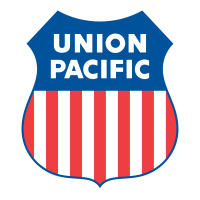- Chart
- Upturn Summary
- Highlights
- Revenue
- Valuation
 Upturn AI SWOT
Upturn AI SWOT - About
Union Pacific Corporation (UNP)

- BUY Advisory
- SELL Advisory (Profit)
- SELL Advisory (Loss)
- Profit
- Loss
- Pass (Skip investing)
 Stock price based on last close
Stock price based on last close (see disclosures)
- ALL
- 1Y
- 1M
- 1W
Upturn Advisory Summary
11/26/2025: UNP (1-star) is currently NOT-A-BUY. Pass it for now.
1 Year Target Price $260.4
1 Year Target Price $260.4
| 13 | Strong Buy |
| 3 | Buy |
| 12 | Hold |
| 0 | Sell |
| 1 | Strong Sell |
Analysis of Past Performance
Type Stock | Historic Profit -7.36% | Avg. Invested days 34 | Today’s Advisory PASS |
Upturn Star Rating  | Upturn Advisory Performance | Stock Returns Performance |
Key Highlights
Company Size Large-Cap Stock | Market Capitalization 137.51B USD | Price to earnings Ratio 19.66 | 1Y Target Price 260.4 |
Price to earnings Ratio 19.66 | 1Y Target Price 260.4 | ||
Volume (30-day avg) 29 | Beta 1 | 52 Weeks Range 202.16 - 252.32 | Updated Date 11/28/2025 |
52 Weeks Range 202.16 - 252.32 | Updated Date 11/28/2025 | ||
Dividends yield (FY) 2.34% | Basic EPS (TTM) 11.79 |
Analyzing Revenue: Products, Geography and Growth
Revenue by Products
Product revenue - Year on Year
Revenue by Geography
Geography revenue - Year on Year
Earnings Date
Report Date - | When - | Estimate - | Actual - |
Profitability
Profit Margin 28.73% | Operating Margin (TTM) 41.03% |
Management Effectiveness
Return on Assets (TTM) 9.2% | Return on Equity (TTM) 41.62% |
Valuation
Trailing PE 19.66 | Forward PE 18.25 | Enterprise Value 168858490656 | Price to Sales(TTM) 5.6 |
Enterprise Value 168858490656 | Price to Sales(TTM) 5.6 | ||
Enterprise Value to Revenue 6.88 | Enterprise Value to EBITDA 13.21 | Shares Outstanding 593160889 | Shares Floating 591369543 |
Shares Outstanding 593160889 | Shares Floating 591369543 | ||
Percent Insiders 0.12 | Percent Institutions 87.06 |
 Upturn AI SWOT
Upturn AI SWOT
Union Pacific Corporation

Company Overview
 History and Background
History and Background
Union Pacific Corporation was founded in 1862. A key role in completing the First Transcontinental Railroad was achieved in 1869. Throughout its history, it has grown through acquisitions and mergers, becoming one of the largest freight railroads in North America.
 Core Business Areas
Core Business Areas
- Freight Transportation: Primarily involved in transporting goods across North America, including agricultural products, chemicals, coal, industrial products, and intermodal containers.
 Leadership and Structure
Leadership and Structure
Lance Fritz served as CEO until August 2023, at which point Beth Whitsitt became CEO. The company operates with a typical corporate structure including a board of directors and various executive leadership positions overseeing different operational and financial departments.
Top Products and Market Share
 Key Offerings
Key Offerings
- Agricultural Products: Transports grains, fertilizers, and other agricultural commodities. Competitors include BNSF, Canadian National, and trucking companies. Specific market share data is difficult to precisely ascertain, but UP competes for a significant portion of agricultural rail freight.
- Market Share: Approximately 40% of the market
- Chemicals: Transports industrial chemicals, plastics, and petroleum products. Competitors are BNSF, Norfolk Southern, and trucking. Market share details are not publicly published with high precision.
- Market Share: Approximately 30% of the market
- Coal: Transports coal to power plants and export terminals. Competitors are BNSF and trucking. Market conditions have significantly impacted coal transport volumes.
- Market Share: Approximately 25% of the market
- Industrial Products: Transports construction materials, steel, minerals, and ores. Competitors are BNSF, Norfolk Southern, CSX, and trucking. Market share details are not publicly published with high precision.
- Market Share: Approximately 28% of the market
- Intermodal: Transports shipping containers and truck trailers. Competitors include BNSF, trucking companies, and other railroads. Market share data is not usually published with high precision.
- Market Share: Approximately 27% of the market
Market Dynamics
 Industry Overview
Industry Overview
The railroad industry is a vital component of the North American transportation system, facing challenges from trucking, regulatory pressures, and economic cycles. It is capital intensive and subject to cyclical demands related to the commodity prices of the goods they carry.
Positioning
Union Pacific is one of the largest Class I railroads in the United States, possessing a significant network and infrastructure. Its competitive advantages include network reach, operational efficiency, and access to major markets.
Total Addressable Market (TAM)
The total addressable market for freight transportation in North America is estimated to be hundreds of billions of dollars annually. Union Pacific commands a sizable portion of this, with freight revenue making up a large amount. They are well positioned to leverage existing infrastucture to take advantage of demand.
Upturn SWOT Analysis
Strengths
- Extensive rail network
- High barriers to entry
- Efficient transportation of bulk commodities
- Strong market position in the Western U.S.
- Commitment to sustainability
Weaknesses
- High capital expenditures
- Dependence on commodity prices
- Vulnerable to weather-related disruptions
- Labor relation sensitivities
- Customer concentration risks
Opportunities
- Increased intermodal traffic
- Growth in e-commerce and logistics
- Expansion of international trade
- Technological advancements (e.g., automation)
- Infrastructure improvements
Threats
- Competition from trucking industry
- Economic downturns
- Government regulations
- Fuel price volatility
- Cybersecurity threats
Competitors and Market Share
 Key Competitors
Key Competitors
- BNSF
- CSX
- Norfolk Southern
Competitive Landscape
Union Pacific and BNSF are the dominant freight railroads in the Western US. Union Pacific's competitive strengths include its size, network reach, and focus on efficiency. Key disadvantages include capital expenses. BNSF is its primary competitor.
Major Acquisitions
Southern Pacific
- Year: 1996
- Acquisition Price (USD millions): 5400
- Strategic Rationale: Expansion of its rail network, consolidating routes to cover more of the Western US. A key strategic advantage.
Growth Trajectory and Initiatives
Historical Growth: Union Pacific's growth has been consistent. However it has not been linear due to economic conditions.
Future Projections: Future growth projections are dependent on economic conditions and analysts estimates. Consult financial data providers for estimates.
Recent Initiatives: Recent initiatives from Union Pacific include investment in new technologies and safety.
Summary
Union Pacific is a major freight railroad with an extensive network in the Western United States. Strengths include its size, market position, and commitment to sustainability. Potential challenges include competition from trucking, regulatory pressures, and economic cycles. The company needs to focus on adapting to changing market conditions and customer needs.
Similar Stocks
Sources and Disclaimers
Data Sources:
- Union Pacific Investor Relations
- SEC Filings
- Industry Reports
- Financial News Outlets
Disclaimers:
The information provided is for informational purposes only and should not be considered financial advice. Market share data are estimates and may vary. Investment decisions should be based on thorough research and consultation with a financial advisor.
 AI Summarization is directionally correct and might not be accurate.
AI Summarization is directionally correct and might not be accurate.
 Summarized information shown could be a few years old and not current.
Summarized information shown could be a few years old and not current.
 Fundamental Rating based on AI could be based on old data.
Fundamental Rating based on AI could be based on old data.
 AI-generated summaries may have inaccuracies (hallucinations). Please verify the information before taking action.
AI-generated summaries may have inaccuracies (hallucinations). Please verify the information before taking action.
About Union Pacific Corporation
Exchange NYSE | Headquaters Omaha, NE, United States | ||
IPO Launch date 1978-01-13 | CEO & Director Mr. Vincenzo James Vena | ||
Sector Industrials | Industry Railroads | Full time employees 29576 | Website https://www.up.com |
Full time employees 29576 | Website https://www.up.com | ||
Union Pacific Corporation, through its subsidiary, Union Pacific Railroad Company, operates in the railroad business in the United States. It offers transportation services for grain and grain products, fertilizers, food and refrigerated products, and coal and renewables to grain processors, animal feeders, and ethanol and renewable biofuel producers; and construction products, industrial chemicals, plastics, forest products, specialized products, metals and ores, petroleum, liquid petroleum gases, soda ash, and sand, as well as finished automobiles, automotive parts, and merchandise in intermodal containers. The company was founded in 1862 and is headquartered in Omaha, Nebraska.

Note: This website is maintained by Upturn Corporation, which is an investment adviser registered with the U.S. Securities and Exchange Commission. Such registration does not imply a certain level of skill or training. Investing in securities has risks. Past performance is no guarantee of future returns. No assurance is provided as to any particular investment return, and you may lose money using our services. You are strongly advised to consult appropriate counsel before making any investments in companies you learn about through our services. You should obtain appropriate legal, tax, investment, accounting, and other advice that takes into account your investment portfolio and overall financial situation. You are solely responsible for conducting due diligence on a potential investment. We do not affect trades for you. You will select your own broker through which to transact. Investments are not FDIC insured, they are not guaranteed, and they may lose value. Please see the Privacy Policy, Terms of Use, and Disclosure for more information.
 Home
Home 
